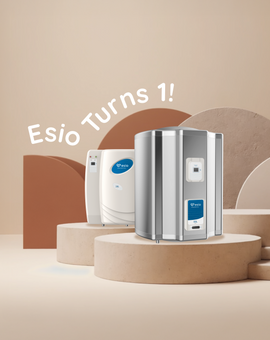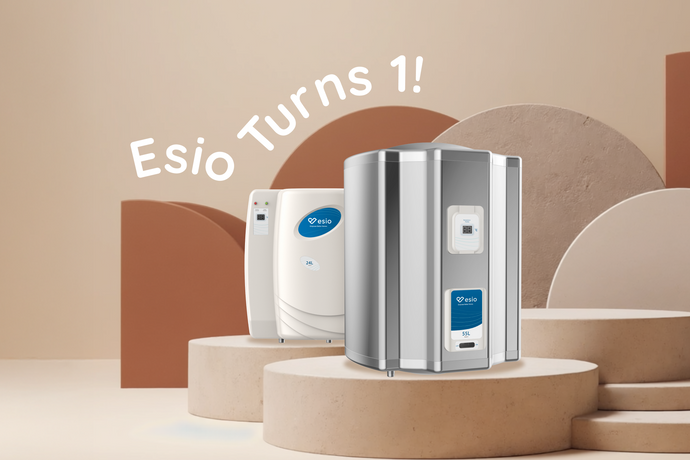Three common reasons for water leakage from the Storage Water Heater:
- The pressure relief valve is leaking
- The water pipe joint is leaking
- The inner tank is leaking
1. The pressure relief valve (safety valve) is leaking
The function of the pressure relief valve: During heating, the water in the storage water heater's inner tank expands due to the principle of thermal expansion, causing an increase in pressure inside the tank. Excessive pressure can potentially damage the pipes and the water heater itself. The protection mechanism of the pressure relief valve will then activate. To reduce the pressure inside, the pressure relief valve automatically releases a small amount of water to relieve pressure.
- Water dripping or a small amount of drainage from the pressure relief valve
Possible reason:
When the pressure inside the inner tank increases, the pressure relief valve releases water through a small hole to relieve pressure.
Recommended solution:
Don’t worry, this is a normal phenomenon with our Storage Water Heater.
- The pressure relief valve is discharging a large amount of water
Possible reason:
It could be due to foreign objects blocking the valve core, sediment buildup, or aging of the spring, causing the safety valve to malfunction.
Recommended solution:
You may slightly tighten the flat-tip type lock hole to reduce the amount of water drainage. If the issue persists, we recommend you to contact technicians or submit an online home repair request through our official website, let Esio’s professional technicians conduct on-site inspection and valve replacement.
Online home repair request 👉 https://my.esiohome.com/pages/request-a-home-repair
💡 Important reminder: When adjusting the valve, avoid over tightening to avoid inadequate pressure relief which may potentially damage the water heater.

Photo above indicates the location of the pressure relief valve. It is typically installed at the cold water inlet.
2. The water pipe joint is leaking
- If it has just been installed,
Possible reason:
If the thread seal tape is not properly wrapped or if there are too few wraps during installation, it is generally recommended to have at least 24 wraps (depending on the thickness of the thread seal tape).
Recommended solution:
We recommend you to contact technicians or submit an online home repair request through our official website, let Esio’s professional technicians conduct on-site inspection and re-wrap the seal tape.
Online home repair request 👉 https://my.esiohome.com/pages/request-a-home-repair
- If it has been in use for some time,
Possible reason:
It is usually caused by ruptures in the inlet and outlet pipes or aging of the thread seal tape.
Recommended solutions:
a. Check inlet and outlet pipes: First, check if there are any obvious ruptures or damages on the inlet and outlet pipes. If any ruptures are found, kindly engage technicians to replace the piping.
b. Replace thread seal tape: If the pipes are in good condition but there’s leakage, it might be due to aging thread seal tape. Kindly engage technicians to re-wrap the thread seal tape. It is generally recommended to have at least 24 wraps (depending on the thickness of the thread seal tape).

3. The inner tank is leaking
The 3 main reasons for storage water heater tank leakage are: aging of the inner tank (sediment of impurities), poor water quality, and excessive water inlet pressure.
- Inner tank aging
Possible reason:
The inner tank ruptures and leaks due to prolonged usage and excessive sediment buildup.
Recommended solution:
We recommend you to contact technicians or submit an online home repair request through our official website, let Esio’s professional technicians conduct on-site inspection and inner tank replacement.
💡 To prevent excessive sediment in the inner tank, it is recommended to clean the inner tank annually. This helps to reduce the risk of tank damage.
- Poor water quality
Possible reason:
Poor quality of tap water (containing sediment and impurities) leads to the formation of hardened deposits in the tank due to sediment buildup. These deposits weaken the tank over the time, eventually leading to inner tank rupture.
Recommended solution:
Submit home repair request, let Esio’s professional technicians conduct an on-site inspection and replace the inner tank. Following the replacement, it's advisable to install a home water filter system afterwards. Water filter system not only preserves the lifespan of your household pipes and water heater but also ensures the cleanliness of your bathing water, enhancing overall water safety.
- Excessive water inlet pressure
Possible reason:
Excessive water inlet pressure increases the risk of inner tank rupture and leaks.
Recommended solution:
Submit home repair request, let Esio’s professional technicians conduct an on-site inspection and replace the inner tank. At the same time, check if the booster pump has been adjusted. If so, reduce the water pressure. If the pressure is too high, request technicians to install a pressure reducing valve at the cold water inlet to reduce the water inlet pressure.
💡 Esio recommends maintaining the water inlet pressure at or below 2 bar. Exceeding this pressure threshold can result in increased drainage from the safety valve (due to increased pressure that needs to be released), and it may also reduce the lifespan of the inner tank.
Before attempting the suggested fixes or addressing the water leakage issue mentioned above, please ensure to follow the operational guidelines strictly. Kindly seek professional technical support if needed. If Esio’s technicians support is required, do submit the home repair requests through the link:https://my.esiohome.com/pages/request-a-home-repair


